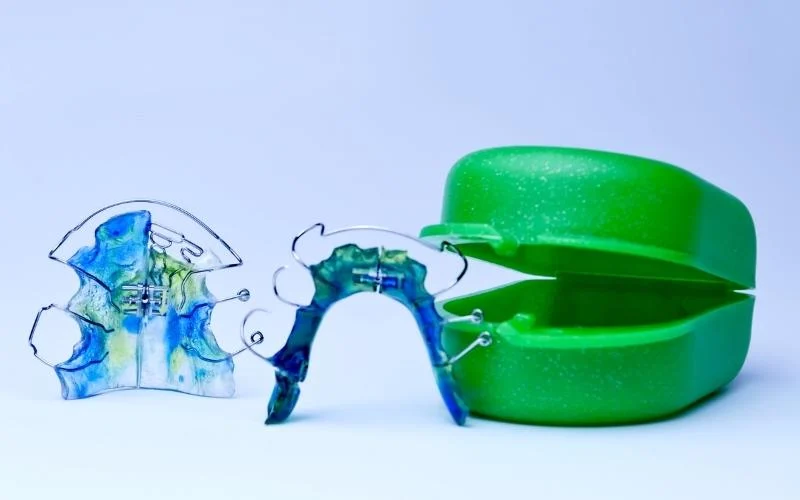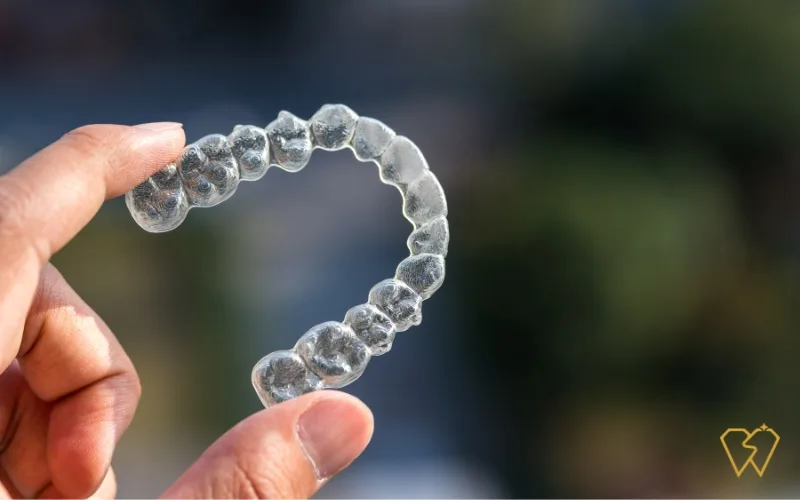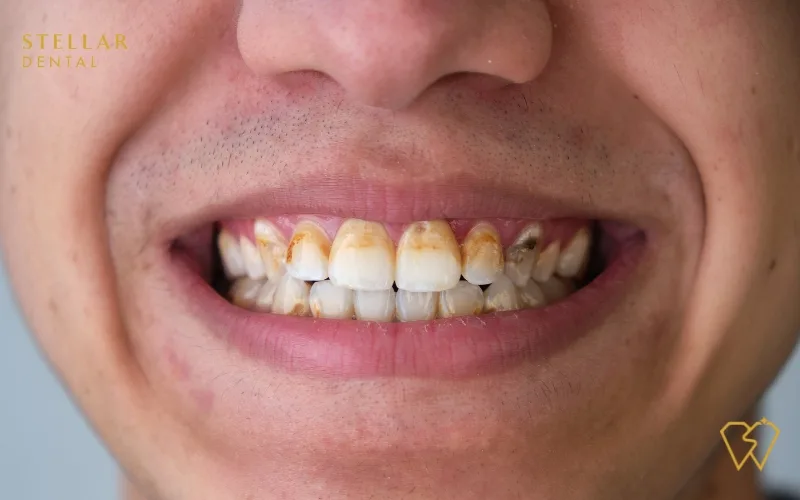Now that your dentist has removed your braces, you may believe your orthodontic treatment is over. Unfortunately, this is not true. Straightening your teeth is only half the battle. The other half is to keep them that way. Teeth retainers come in handy in this situation. Many people wear retainers for years after removing their braces to keep their teeth straight and their smiles bright.
What is a teeth retainer?
A retainer is an appliance worn after teeth braces treatment to protect the results. Some may call them dental retainers or braces retainers. There are several types of retainers, but they all serve the same purpose: to “retain” the treatment benefits and keep teeth from shifting out of alignment. A retainer is essential to treatment because it keeps your smile in place and your teeth healthy.

Why you should wear teeth retainers
Even after braces have straightened your teeth, they are only partially stable in their new position. This only happens once the gums, bones, and muscles adjust to the new situation. Everyday habits such as chewing and grinding put force on your teeth and can cause them to move. Malocclusion can also be caused by shifting teeth. When you close your mouth, your upper and lower teeth do not align.
For a long time, your braces kept your teeth straight. After removing braces, nothing can prevent your teeth from returning to their original position. Wearing a retainer keeps your teeth in place and prevents them from moving. Consider the following: Braces straighten your teeth, but retainers keep them straight. They aid in the “retention” of your teeth’s new position.
Types of teeth retainers
There are two main types of retainers:
- Removable teeth retainers
- Fixed or permanent teeth retainers
Removable teeth retainers
These are the retainers that you can insert and remove yourself. In traditional retainers (Hawley), a piece of wire is attached to a piece of plastic (or acrylic). Clear retainers (Essix) are also made of plastic but lack wires. Both are made to fit your teeth perfectly.
Hawley retainer
Hawley retainers are made of plastic (or acrylic) and thin metal wire. Some people call it a metal retainer. These retainers have a shape to fit the roof of your mouth or the inside of your lower teeth. They are also known as wire retainers. The attached metal wire runs around your teeth to keep them aligned.
Hawley retainer advantages:
- It can be adjusted if you need a better fit or minor realignment later.
- A Hawley retainer lasts slightly longer than a clear plastic retainer.
- It is repairable if it gets broken.
- If used and cared for properly, Hawley retainers can last for years.
- With this type of retainer, the top and bottom teeth touch naturally.
Hawley retainer disadvantages:
- It has a more significant impact on your speech than other retainers.
- It is more noticeable than the other types of retainers.
- The wire may irritate your lips or cheeks.
- The average cost ranges between RM300-600
Essix retainer (Clear plastic retainers)
These removable retainers are custom-molded to fit your teeth’ new position. Molded or Essix retainers are another name for them. (Technically, they are known as thermoplastic or vacuum-formed retainers.)
A mold of the teeth is created to create this type of retainer. Afterward, a thin layer of plastic or polyurethane is heated and sucked down around the mold.
Essix retainer benefits:
- You are more likely to wear it because it is nearly invisible. Relapse is, therefore, less likely.
- It’s less noticeable and possibly more comfortable than a Hawley retainer.
- It has less effect on your speech than a Hawley retainer.
Essix retainer drawbacks:
- If you require realignment, it cannot be adjusted. It’d have to be replaced.
- This type of retainer cannot be repaired if it breaks.
- It may have a more significant impact on your speech than permanent retainers.
- It discolors (and becomes more visible) over time.
- With this type of retainer, the upper and lower teeth do not naturally touch.
- It has the potential to trap liquids against your teeth, causing cavities.
Depending upon the type of plastic used, three common brands of clear retainers are Vivera, Essix, and Zendura.
Vivera is sometimes incorrectly referred to as Invisalign. The same company manufactures the two products, but Invisalign is a tooth-straightening aligner rather than a retainer.
Clear plastic retainers have grown in popularity and are now used more frequently than Hawley retainers. On average, one tray costs between rm200-400
Pros and cons of removable teeth retainers
Removable retainer pros:
- They come off quickly when you want to eat, brush, or floss your teeth.
- They’re relatively simple and convenient to get.
Removable retainer cons:
- You can misplace or lose them when they’re not in your mouth.
- If left around, they get damaged easily.
- They can cause excessive salivation.
- Bacteria can live and grow on them.
Relapse with removable retainers is common. A retainer can’t do its job when you don’t wear it, and your teeth will try to revert to their original position. There are two types of removable retainers: Hawley retainers and clear plastic retainers.
Fixed teeth retainer
Fixed retainers are made up of a solid wire shaped to fit your teeth. The wire is attached to the inside of the front teeth to prevent them from moving. These retainers are commonly used on lower teeth and are also known as bonded retainers, permanent retainers, or lingual wire retainers. Only a dentist or an orthodontist can remove them.
A fixed retainer is used when the teeth are likely to relapse, or there is a risk that the person (such as a young child) will not follow the instructions. Although some fixed retainers are left indefinitely, the majority are removed after a specific time due to excessive plaque and tartar buildup or gum irritation.
Fixed teeth retainer pros and cons
Fixed teeth retainer pros:
- There is no need to remember when and how long to wear it.
- Others are unable to see it.
- A permanent retainer is unlikely to affect your speech.
- It cannot be misplaced or misplaced.
- It is not easily damaged.
Fixed teeth retainer cons:
- Because you can’t remove it, it may be difficult to maintain oral hygiene, particularly flossing. This can result in tartar and plaque buildup, potentially leading to gum disease.
- Your tongue may be irritated by the metal wire.
- Permanent retainers, like your teeth, should be cleaned daily. A threader can help you get dental floss underneath the wire and remove food, plaque, and tartar.
The average cost ranges between RM400-1000
The procedure for getting dental retainers
The procedure for getting a retainer differs depending on the type.
Removable retainers procedure:
Your dentist uses dental putty to make a dental impression. Dental putty is a soft material like play dough. They put the putty in trays, which they then place over your teeth. This imprints your distinct bite and tooth arrangement into the putty.
A dental laboratory uses the mold to make your desired teeth retainer. Typically, you must wait a week or more before receiving the retainer.
It should be noted that many dental offices use digital impressions. Digital impressions are an alternative to the previously mentioned traditional impressions. Your dental provider uses a wand to capture digital images of your teeth and gums. Computer software then uses these images to create a three-dimensional model of your mouth.
Fixed retainers procedure:
Your dentist uses a metal wire to measure the proper placement of your teeth. They use cement to secure the wire. This time-consuming procedure takes longer than making an impression for a removable retainer. However, you leave the dentist’s office with your retainer still in place. The retainer does not need to be created in a laboratory.
Do retainers hurt?
Some people experience minor discomfort while wearing a retainer. Depending on the severity of the condition being treated, this could last one or several days. It should be noted that getting a retainer fitted is a painless procedure. As your mouth adjusts to its new shape, you may feel pressure or soreness in your teeth and gums. If your retainer irritates or bleeds your gums, consult your dentist or orthodontist to have the fit adjusted.
How long do you have to wear teeth retainers?
According to one study, after your braces are removed, you should wear your retainer all day for up to a year. Then you should follow your dentist’s instructions. They will tell you whether you should keep wearing your retainer and whether you should wear it at night. In most cases, indefinitely wearing your retainer at night will be recommended to maintain your teeth’s position and bite.
These instructions may differ if your dentist or orthodontist has you wear a retainer for reasons other than straightening your teeth. Your dentist can advise wearing it for some time if you have speech issues. When it comes to how long to wear retainers, it’s always best to listen to your dentist or orthodontist.
What if you don’t wear your teeth retainer?
Just because your orthodontic treatment is finished does not guarantee that your teeth will remain in place. Suppose you do not wear your retainer as frequently as your dentist advised. In that case, your teeth will relapse to their original position. This is referred to as relapsing. If you do not wear your retainer, you may require orthodontic treatment again within 10 years, if not sooner.
If you skip wearing your retainer for an extended time, your teeth may shift, and your retainer will no longer fit properly.
What to do if you break your dental retainer?
If you break your retainer, your dentist or orthodontist will most likely advise you to get a new one. Your insurance may or may not cover the charges of replacement. If you break a permanent retainer, try to get a new one as soon as possible. It may take several weeks for a new set of removable retainers to be ready. Keep an extra retainer on hand in case of an emergency.
How to clean a teeth retainer
Maintaining the cleanliness of your retainer protects your teeth. It can also help to extend the life of a removable retainer.
How to clean a removable retainer
Every time you remove your removable retainer, clean it with lukewarm water. Rinsing your retainer while still wet with saliva prevents food from hardening.
If your orthodontist recommends, you can buy a special soaking product to soak your retainer between uses.
You should also scrub your retainer with a soft-bristled toothbrush and toothpaste once a day. However, proceed with caution because many kinds of toothpaste are abrasive and can scratch your retainer. Consider consulting with your orthodontist about which type to use.
If food debris becomes trapped in your retainer, clean it with a clean cotton swab dipped in water.
How to clean a fixed teeth retainer
Clean your fixed retainer daily as part of your oral hygiene schedule. Because a fixed retainer cannot be removed, use a floss threader to floss your retainer (as well as the front of your teeth).
You’ll get the hang of it after some practice. Also, angle your toothbrush vertically and horizontally to remove any plaque or food particles around your fixed retainer.
How to get your child used to wearing a retainer?
Your child may feel sore teeth for the first few days after starting to wear their retainer. While this is natural, it may cause them to dislike wearing their retainer. Here are some tips to make it easy for your children to wear their retainers:
- Make the retainer unique by including a picture of your child’s favorite TV or book character. This may make your child more eager to put on the retainer every night.
- Be patient, and never stop reminding your child to wear the retainer.
- Encourage your child to wear their retainer by rewarding them, especially in the first few weeks.
- Make a note of it and place it in your child’s retainer case. When your child opens the case, this could be a fun surprise for them.
It can be challenging to persuade your child to wear their retainer daily for extended periods. However, explaining the purpose of retainers and reminding them to wear it can go a long way. Wearing a retainer should become a habit for your child that will last a lifetime, just like having a beautiful smile!
Are there any risks associated with dental retainers?
Despite the numerous advantages of continuous use of retainers, people who must wear them face many challenges, most of which affect them at the start of the process. The most common is becoming accustomed to wearing retainers. Most patients, especially younger ones, forget to wear their retainers or carry the case where they should be placed in case they need to remove them, such as when eating.
Fortunately, these challenges eventually become a regular part of the patient’s life.
Fixed or permanent retainers are also associated with additional risks. Because these cannot be removed for cleaning, they can make brushing and flossing difficult. There is a risk of developing tartar or gingivitis. Fixed retainers can also become loose over time. If this happens, the patient must visit the dentist to replace the retainers.
Patients who wear retainers should see their dentist regularly for the duration of their use to avoid risks and complications.
Teeth retainers price
How much a retainer cost depends on the type you choose, the clinic you go to, and the clinic area. At Stellar Dental, our prices for teeth retainers in Malaysia (per arch) are as follows:
- Essix retainer is RM300
- Hawley Retainer RM450
- Permanent Retainer RM500
Final Words
Orthodontic treatment allows you to restore your smile and correct flaws that cause damage. Dental retainers are also part of your treatment. Each retainer type has advantages and disadvantages. Your orthodontist recommends the best type based on your teeth and a combination of removable and permanent may be suggested in some cases. Get the type of retainer that works best for you because you will most likely be using it for many months or years.
Stellar Dental provides cutting-edge orthodontic retainers at Setia Alam and Kota Damansara to ensure your new smile stays beautiful. To find out if you need a retainer after removing your braces, schedule an appointment by clicking the button below or call us at +6011-2884 0342.









